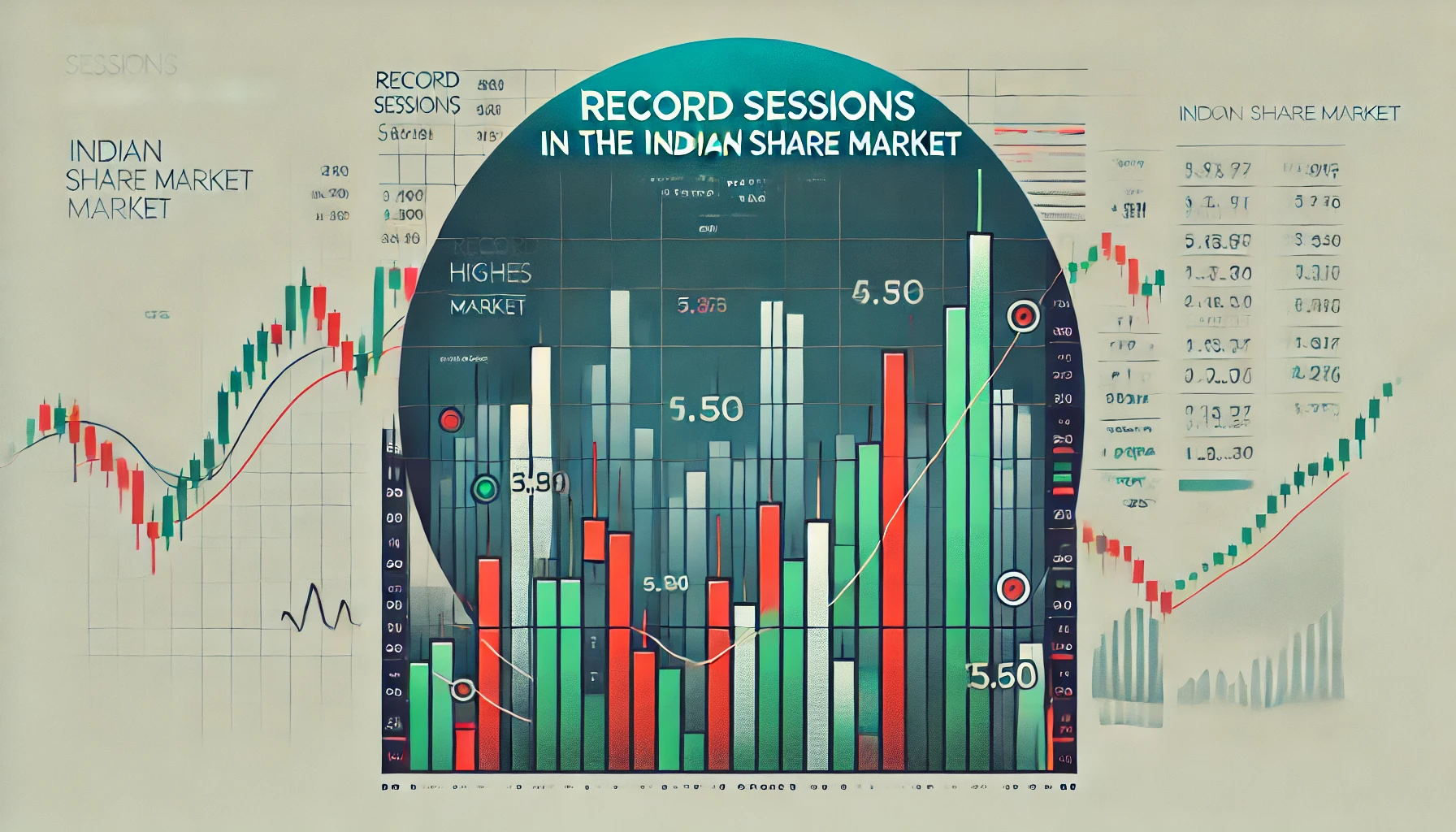Candlestick patterns are powerful tools used by traders in the Indian share market to analyze price movements and make informed decisions. One such prominent candlestick pattern is the Marubozu. The Marubozu pattern indicates strong market sentiment, with no wicks or shadows, signaling a clear trend direction. This blog will explore the Marubozu candlestick, its types, significance in the Indian share market, and how it has influenced stock prices historically.
What is a Marubozu Candlestick?
A Marubozu candlestick is one that has no upper or lower shadows, meaning the open and close prices are at the extremes of the trading session. This candlestick signifies strong market sentiment, whether bullish or bearish.
| Candlestick Characteristics | Marubozu Pattern |
|---|---|
| Open Price = Low Price | True (Bullish) |
| Open Price = High Price | True (Bearish) |
| No Upper or Lower Shadows | True |
A Marubozu forms when buyers or sellers completely dominate the market, leading to a candlestick with no shadows. This clear trend can be very useful in identifying strong market momentum.
Types of Marubozu Patterns:
There are two main types of Marubozu candlestick patterns:
- Bullish Marubozu:
- This pattern occurs when the stock opens at the lowest price and closes at the highest price of the session. It indicates strong buying pressure and suggests that prices will continue to rise.
- Bearish Marubozu:
- In this pattern, the stock opens at the highest price and closes at the lowest price of the session. This signifies strong selling pressure and suggests that prices will continue to fall.
Interpretation of Marubozu in the Indian Share Market
The Marubozu candlestick can be a powerful signal for traders in the Indian stock market, as it shows a clear direction in market sentiment. Here’s how to interpret each type of Marubozu:
- Bullish Marubozu in an Uptrend: A Bullish Marubozu in an uptrend is a strong indication that the market is likely to continue its upward movement. Traders often see this as a sign to enter or hold long positions.
- Bearish Marubozu in a Downtrend: A Bearish Marubozu in a downtrend confirms that the market is likely to continue falling. This is often seen as a signal to enter short positions or exit long trades.
| Marubozu Type | Market Sentiment | Expected Outcome |
|---|---|---|
| Bullish Marubozu | Strong Buying | Uptrend Continuation |
| Bearish Marubozu | Strong Selling | Downtrend Continuation |
Historical Examples of Marubozu in the Indian Share Market
Several instances of Marubozu candlesticks in the Indian stock market have led to significant price movements. Below are a few historical examples:
- HDFC Bank (March 2020): In March 2020, a Bearish Marubozu formed on HDFC Bank’s chart following an uptrend. This was one of the first signs of the sharp market decline that followed in the wake of the global pandemic.
- Tata Steel (May 2021): A Bullish Marubozu appeared on Tata Steel’s chart during May 2021 after a period of consolidation. The stock surged by over 15% in the weeks following the Marubozu formation.
| Stock/Index | Date | Marubozu Type | Resulting Trend |
|---|---|---|---|
| HDFC Bank | March 2020 | Bearish Marubozu | Continued Downtrend |
| Tata Steel | May 2021 | Bullish Marubozu | Uptrend (15% Surge) |
How to Trade Using Marubozu in the Indian Share Market
The Marubozu candlestick pattern is a valuable signal, but it is essential to combine it with other technical indicators to improve accuracy. Here are some effective trading strategies:
- Marubozu with Support and Resistance: A Bullish Marubozu breaking above a key resistance level is often a strong confirmation of a bullish breakout. Similarly, a Bearish Marubozu breaking below a support level can indicate a bearish breakdown.
- Marubozu with Moving Averages: When a Marubozu forms near a significant moving average (e.g., 50-day or 200-day moving average), it can be an excellent confirmation of the trend’s strength.
- Marubozu with Volume: High volume accompanying a Marubozu candlestick indicates that the move is supported by strong market participation, making it a more reliable signal.
Limitations of the Marubozu Pattern
While the Marubozu pattern is a strong signal of market sentiment, it is not without its limitations. Traders should be cautious and consider the following:
- False Signals: The Marubozu can give false signals, especially in choppy or highly volatile markets. Always confirm with other indicators before making significant trades.
- Reversal Risks: Sometimes, a Marubozu may occur during a market overextension, leading to a rapid reversal. Traders should look for confirmation from subsequent candles.
Case Study: Marubozu and Nifty 50
In June 2021, the Nifty 50 index experienced a Bullish Marubozu, signaling the start of a new rally that lasted for several months. This candlestick pattern provided early insight into the continued uptrend in the index, offering traders a key opportunity.
| Date | Index | Marubozu Type | Post-Pattern Movement |
|---|---|---|---|
| June 2021 | Nifty 50 | Bullish Marubozu | Uptrend Continuation |
How to Incorporate Marubozu in Trading Strategies
To effectively use the Marubozu pattern in trading, consider the following strategies:
- Wait for Confirmation: Always wait for the next candlestick to confirm the Marubozu’s signal. If the next candle continues in the same direction, it reinforces the pattern’s reliability.
- Use Stop-Loss Orders: Setting a stop-loss just below a Bullish Marubozu or above a Bearish Marubozu helps manage risk in case the trend reverses unexpectedly.
- Combine with Other Indicators: Marubozu patterns are most effective when used in conjunction with other indicators like RSI, Bollinger Bands, or Moving Averages. This helps filter out false signals.
Conclusion:
The Marubozu candlestick pattern is a powerful indicator in the Indian share market, signaling strong market sentiment and potential continuation of trends. Whether bullish or bearish, the Marubozu pattern provides traders with clear, actionable insights into market direction.
However, like all technical indicators, it is essential to use the Marubozu in combination with other tools to confirm its signals and improve accuracy. By understanding its nuances and historical significance in the Indian share market, traders can better leverage this pattern to maximize their trading potential.

What is the TRIN stock market indicator?
The TRIN (Trading Index), also referred to as the Arms Index, is a technical analysis …

Record Sessions
The Indian share market is a dynamic and volatile space where major highs and lows …

3 Line Strike
Candlestick patterns are a vital tool for traders in the stock market, offering insights into …

3 White Soldiers and 3 Black Crows
Candlestick patterns are a key element of technical analysis in stock trading, offering clear signals …

Gapping Doji
Candlestick patterns are a critical part of technical analysis in the stock market, providing traders …

3 Windows
Candlestick patterns are a vital part of technical analysis, offering traders and investors insights into …

2 Gapping Candles
In the fast-paced world of the Indian stock market, technical analysis plays a crucial role …

3 Inside Down and Up
Candlestick patterns are powerful tools in the world of technical analysis, offering traders insight into …

Bullish and Bearish Belt Hold
Technical analysis is an essential part of trading in the Indian share market. Candlestick patterns, …

Piercing and Dark Cloud Cover
In the ever-evolving Indian stock market, candlestick patterns are crucial for traders aiming to predict …

Double Doji
Candlestick patterns have long been a favored tool for technical traders to forecast market movements. …

Rising and Falling Windows
In the world of technical analysis, candlestick patterns are vital tools for traders to anticipate …

Tweezer Top and Bottom
In the fast-paced world of the Indian share market, traders use technical analysis tools to …

Morning Star and Evening Star
In the Indian share market, technical analysis is a valuable tool for traders aiming to …

Hammer and Hanging Man
The Indian stock market offers a wealth of opportunities for traders who understand technical analysis. …

Shooting Star and Inverted Hammer
The Indian stock market, with its dynamic nature, presents various opportunities for traders and investors. …

Last Engulfing
The Indian share market is filled with patterns that can help traders make informed decisions. …

Harami
In the world of stock market analysis, candlestick patterns offer valuable insights into price movements. …

Engulfing
The Indian share market is known for its volatility, and traders often rely on technical …

Marubozu
Candlestick patterns are powerful tools used by traders in the Indian share market to analyze …

Spinning Top
The Indian share market, like any other, experiences constant fluctuations due to a multitude of …

Doji
The Indian share market is dynamic, with investors using various tools to gauge stock performance. …

Double Top
In the world of technical analysis, chart patterns are valuable tools that help traders spot …

Tweezer
In the Indian share market, where volatility and price fluctuations are part of daily trading, …

Harami
In the world of technical analysis, candlestick patterns are powerful tools that help traders make …

Heiken-Ashi
Navigating the Indian share market can be challenging due to the inherent volatility and market …

Ichimoku
In the world of technical analysis, few indicators offer the comprehensive insights that the Ichimoku …

Value Charts
In the ever-changing landscape of the Indian share market, traders and investors need tools that …

Money Flow Index
In the Indian share market, identifying trends, understanding momentum, and assessing volume are critical components …

Aroon
In the fast-paced world of the Indian share market, identifying market trends and spotting reversals …

Gator Indicator
In the Indian share market, success is largely dependent on identifying the right trends and …

Adaptive Moving Average
In the dynamic and often volatile Indian share market, traders and investors continuously seek tools …

Coppock Curve
In the ever-evolving landscape of the Indian share market, traders and investors rely on technical …

Premier Stochastic Oscillator
In the fast-paced world of the Indian share market, technical indicators are indispensable tools that …

Dynamic RSI
The Indian share market is known for its volatility, with frequent shifts in trends influenced …

Vortex
The Indian share market offers plenty of opportunities for traders and investors to capitalize on …

Glitch Index
The Indian share market, like all financial markets, is prone to moments of irregular behavior—unexpected …

Triple Exponential Average
Navigating the Indian share market requires traders to use effective tools that help them track …

Know Sure Thing
The Indian share market presents countless opportunities for traders and investors, but making accurate decisions …

Mass Index
The Indian share market is volatile, with price trends constantly shifting due to numerous factors. …


















